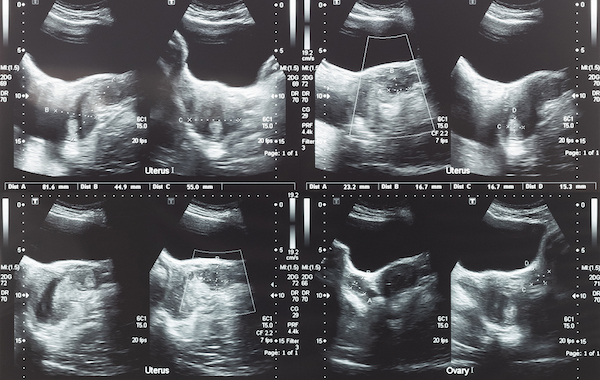Can uterine fibroids harm my pregnancy?
March 31, 2020

Early in pregnancy, it's not uncommon to diagnose a patient with preexisting conditions that might cause concern during the next nine months.
While diabetes and high blood pressure are common concerns we diagnose during pregnancy, 1% to 10% of expectant moms are found to have uterine fibroids – abnormal but noncancerous tissue growths inside the uterus – during a prenatal ultrasound. For some this is a new finding, but many women are already aware they have them.
Uterine fibroids are common. By age 35, 40% to 60% of women will have developed these growths, which can cause abdominal bulkiness and heavy or painful periods.
Even so, the diagnosis can be alarming for some patients. I have weird tissue growing near my baby? What does that mean for my pregnancy?
While there is a large amount of research on fibroids in nonpregnant patients, data are limited on how fibroids can affect pregnancy. Thankfully, we do know that most patients with fibroids will have an uneventful pregnancy and delivery.
Having a few small fibroids is rarely cause for concern. However, depending on the location of your fibroids, how many you have, and whether they are large – fibroids can range from the size of a coin to a basketball – we will monitor for certain situations that can cause problems during pregnancy.
"While diabetes and high blood pressure are common concerns we diagnose during pregnancy, 1% to 10% of expectant moms are found to have uterine fibroids during a prenatal ultrasound."
Fetal risks related to fibroids
In general, risk to the growing baby is low. If you have large or multiple fibroids, we'll watch closely for a few potential concerns:
- Abnormal placenta: Fibroids have been associated with placenta previa (implantation of the placenta over the cervix) and placental abruption (premature separation of the placenta from the uterus). Your doctor can use ultrasound to check the placenta during pregnancy.
- Fibroid growth: Research suggests that approximately two thirds of fibroids will grow or shrink during pregnancy. If growth occurs, it's typically during the first trimester. Your Ob/Gyn may check the size of your fibroids via ultrasound to monitor changes and evaluate the growth of your baby. To date, research has not shown an absolute correlation between fibroids and fetal growth restriction.
- Breech position: If your fibroids limit space in the uterus, your baby may be breech – bottom down instead of head down. Using ultrasound and a physical exam, we monitor the baby's position as you get closer to your due date. If your baby is not head down your doctor might recommend cesarean section (C-section) delivery.
- Preterm delivery: Significant fibroid burden may stress the uterus, leading to preterm contractions or premature rupture of membranes (when your water breaks before 37 weeks) and subsequent delivery. It is important to contact your Ob/Gyn if you think you may be in labor or leaking fluid.

Risks for pregnant women with fibroids
Knowing the position and size of your fibroids can help you and your care team prepare for potential labor and delivery complications, such as:
- Incomplete cervical dilation: Crowding in the lower uterine area due to bulky fibroids can block the opening of the birth canal. Obstruction from fibroids in this area can increase the risk of needing a C-section.
- Poor contracting: Disruption of normal uterine tissue from fibroids may result in weak contractions. This makes it difficult to reach complete cervical dilation when in labor and may necessitate C-section delivery.
- Postpartum hemorrhage: Poor contracting can lead to bleeding after delivery. If the uterus can't contract, uterine blood vessels that fed the placenta might continue to bleed. Postpartum hemorrhage is a medical emergency and usually occurs within 24 to 48 hours after delivery. If you experience heavy vaginal bleeding, call your doctor right away.
Vaginal delivery often is possible and is generally preferred to avoid the risks associated with C-section. Your doctor will talk with you about your personal risk factors, if any, throughout the pregnancy. In some cases, the doctor will recommend a planned C-section.
Related reading: What's going on with my uterus? 3 conditions related to pelvic pain and bleeding
Our patients sometimes ask what they can do to get rid of fibroids during pregnancy. Unfortunately, not much. It is rare for a fibroid removal procedure to be recommended during pregnancy – disturbing the uterine environment during can present risks for the mother and baby.
However, there are many options to consider for shrinking or removing fibroids after the delivery.
Fibroid treatment after pregnancy
For nonpregnant patients, fibroid treatment procedures are generally safe and effective. We recommend that patients wait at least six months after delivery to consider a fibroid removal procedure.
We make this recommendation for two reasons. First, the uterus will shrink during the postpartum period. Once the body recovers, you can assess how much the fibroids affect your daily life.
Second, fibroid removal surgery requires some downtime for recovery. New moms are already healing from delivery and trying to establish a routine at home. Having a non-emergency procedure on top of that can lead to unnecessary stress.
Treatment options
Your Ob/Gyn can help you choose the best fibroid treatment. We offer options that range from totally noninvasive to removal of the uterus, based on your goals and symptoms.
Talk with your doctor about the severity of your symptoms and whether you might want to become pregnant again before choosing a treatment.

Innovative treatment for fibroid ablation
UT Southwestern is among a handful of medical centers in the region to offer radiofrequency ablation, a minimally invasive surgical treatment for uterine fibroids. This advanced technology uses heat to shrink uterine fibroids.
Women in our office often choose one of these five therapies:
- Medication: Your doctor can recommend options to manage symptoms or shrink the fibroids. Some of these might include anti-inflammatory drugs such as ibuprofen or hormonal birth control to help relieve heavy periods. Taking iron supplements can help with iron-deficiency anemia, which can be associated with heavy periods.
- Myomectomy: A surgical procedure in which fibroids are removed and the uterus is reconstructed. You might choose myomectomy if you want to become pregnant in the future. Plan for approximately four to six weeks of recovery before returning to normal activities. Myomectomy is currently the standard of care for surgical treatment of fibroids in women that desire pregnancy in the future. C-section is frequently recommended in pregnancy that occurs after a myomectomy.
- Uterine fibroid embolization: This procedure is performed by interventional radiologists and starves the fibroids of blood, causing them to shrink by 40% to 60% over time. Pregnancy is possible after this treatment. However, there may be an increased risk of abnormal adherence of the placenta to the uterus, potentially causing problems during pregnancy. Patients might also be at increased risk of needing a C-section.
- Radiofrequency ablation: This therapy spares the uterus and requires less recovery time than myomectomy. Using minimally invasive surgical techniques, the doctor heats each fibroid, causing it to shrink up to 50%. Healthy pregnancies have been reported after this therapy. However, it is a relatively new technique and more research is needed.
- Hysterectomy: If you do not desire a future pregnancy and your fibroids are impacting your daily life, removing the uterus is an effective treatment. Plan for six weeks of recovery before returning to most normal activities.
Thankfully, the Society for Maternal-Fetal Medicine notes that approximately 76% of fibroids shrink by the postpartum period. And 36% diagnosed in early pregnancy resolve.
If you are experiencing gynecologic issues prior to or during pregnancy, talk with your doctor. We can help manage your fibroid symptoms before and after pregnancy, based on your future family goals.











